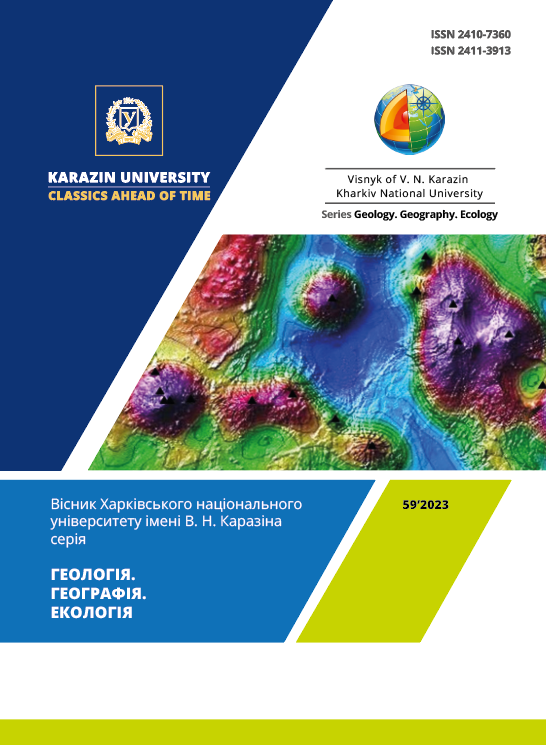Ландшафтно-екологічна каркасна модель міського ландшафту та методи оптимізації міських ландшафтів (на прикладах міст Гянджа і Мінгечевир)
Анотація
У статті окреслено природні та антропогенні основи міських ландшафтів та організацію і моделювання екологічних каркасів. В даний час вплив людської діяльності на території, на ландшафти, особливо на міські ландшафти, інколи призводить до кардинальної зміни та реконструкції кількох одиниць або компонентів ландшафту, деградації чутливих екосистем території, створення повністю антропогенні комплекси. Метою даного досліджен-ня є ландшафтно-екологічне формування міських ландшафтів Азербайджанської Республіки, оптимізація міських ландшафтів, аналіз і узагальнення процесів містобудування на рівні міського створення і середовища проживання, а також визначення основних закономірностей формування цього середовища з урахуванням інноваційних і традиційних процесів. Було проведено екологічний аналіз відповідних міських ландшафтів, і було визначено чотири зони екологічної небезпеки в Гянджі та три в Мінгечавірі (1:20000). Були проаналізовані принципи організації «екосистем» на основі оптимізації обох міських ландшафтів. Визначено ступінь антропогенної порушеності території та складено карту-схему еколого-географічної оцінки ландшафтних комплексів. Проведено дослідження антропогенних змін природних ландшафтів та зроблено оцінку антропогенного впливу у відсотках за фрагментами цифрових електронних карт. У програмі ArcGIS було складено карти нахилу та експозиції схилів місцевості, гіпсометрії рельєфу місцевості, щільності доріг, екогеографічного стану сучасних міських ландшафтів, зон ризику та оптимізації міських ландшафтів тощо. Визначено значення та функціональну роль міста як комплексного середовища життєдіяльності населення країни. У процесі містобудування в Азербайджанській Республіці визначається обличчя міста, композиційна система міської архітектури, нововведення, традиційні риси. У досліджуваних містах визначено основну містоутворюючу функцію та роль річки. Визначено та проаналізовано і лінійні особливості розвитку міст, і відмінності у формуванні. Відповідно, кожне з міст має свої унікальні моделі розвитку. Досліджено екологічні проблеми міст, складено карти екологічних ризиків та оптимізації.
Завантаження
Посилання
Azerbaijan National Atlas (2014), State Land and Cartography Committee of the Republic of Azerbaijan, Baku, 88-92 [in Azerbaijan]
Garibov Y.A. (2012) Optimization of natural landscapes in the Republic of Azerbaijan, Baku, 122 [in Azerbaijan]
Garibov Y.A. (2012) Optimization of natural landscapes of the Republic of Azerbaijan. AzTU printing house, Baku, 216 [in Azerbaijan]
Garibov Y.A. (2011) Anthropogenic transformation of modern landscapes of the Republic of Azerbaijan. Mars Print Baku, 298. [in Azerbaijan]
Hajiyeva G.N., Hajiyeva A.Z., Dadashova Kh.D. (2022) Proceedings of the National Academy of Sciences of the Republic of Kazakhstan Satbayev University, Impact of urban landscape pollution on human health, 39-45 https://doi.org/10.32014/2022.2518-170X.138
Ismailov M.J. (2009) Ecological peculiarities of the landscapes of contact zones in large morphostructures. In the book Problem of Kazakhstan Geography. 1, Karaganda, 71-75.
Khalilov S.H., Safarov S.H. (2001) Scientific-practical survey book. Baku, 106 [in Azerbaijan]
Mahmudov Sh.A. (2001) Technology of Production fields and industrial ecology, Baku, 57-63 [in Azerbaijan]
Mahmudov C.C. (2007) Ministry of Education of the Republic of Azerbaijan, Azerbaijan State University of Economics. Ecology. Baku, 246 [in Azerbaijan]
Mehdiyeva V.Z., Baharchi T. (2016) Socio-economic aspects of ecological economic zoning. Ministry of Education of the Republic of Azerbaijan. Azerbaijan State Economic University. Monograph, Baku, 234 [in Azerbaijan]
Mammadaliyev N.M., Yusifova A.C. (2016) Ministry of Culture and Tourism of the Republic of Azerbaijan, Exposition Text of Mingachevir City History Museum, Mingachevir, 284 [in Azerbaijan]
Mammadov A.E. (2014) Ancient Ganja (based on archaeological research) / Azerbaijan National Academy of Sciences Institute of Archeology and Ethnography. Baku, Teknur, 51-57. [in Azerbaijan]
Mammadov A.M., Aliyev T.V. (2010) Archaeological excavation and field research works of the Ganja archaeological expedition in 2009. Archaeological research in Azerbaijan 2009, Baku, 57 [in Azerbaijan]
Mammadov G.Sh., Jafarov A.B. (2010) Agriculture and agro-industrial complex. Economic and social geography of Azerbaijan. Baku. Publishing house of BSU. 152-153. [in Azerbaijan]
Mammadov G.Sh., Khalilov M.T., Mammadova S.A. (2009) Presidential Library of the Affairs Department of the President of the Republic of Azerbaijan, Atmospheric pollution problem. Ecological atlas. Baku: Cartography factory, 30 [in Azerbaijan]
Mammadov G.Sh. (2007) Socio-economic and ecological basis of efficient use of land resources of Azerbaijan, Baku, 583 [in Azerbaijan]
Mammadova S.I. (2017) Azerbaijan Geographical Society ANAS Acad. Institute of Geography named after H.A. Aliyev. Works of the Azerbaijan Geographical Society, XIX. Baku, 83-98 [in Azerbaijan]
Mammadov R.M., Ismayilov M.C., Hasanov M.S. (2017) Works of the Azerbaijan Geographical Society Geography and natural resources, 1, Baku, 3-5.
Mammadov R.M. (2009) Landscape planning in Azerbaijan (first experience and application). Baku, 583.
Nazaruk M.M. (2016) Revitalization as a step towards ecologically balanced development of the city of Lviv. Bulletin of Lviv University. The series is geographical, 50, 271-276.
Pyle G.F. (1978) “Environmental Risk Factors of Carolina Encephalitis in Man” The Geographical Review, 68, 157-70.
Sen-Mark F.D. (1977) Nature socialization M. Publ. “Progress”, 251-254.
Shannon, G.W. (1977) Space-Time and Illness Behavior”, Social Science and Medicine, 11, 683-89.
Topchiev O. H., Nefedova N.E., Yavorska V.V. (2014) Domestic geography in the context of the formation of Ukrainian statehood. ONU Bulletin. T. 19, issue 4 (23): Geographical and geological sciences. 136-147 [in Ukrainian].
Valishin Y.I. (2017) Psychogeography of city, news of M. State University. Series: Natural Sciences. M., 2, 38.

Цю роботу ліцензовано за Міжнародня ліцензія Creative Commons Attribution 4.0.





